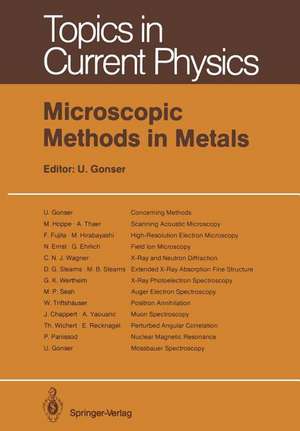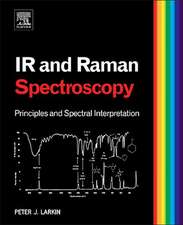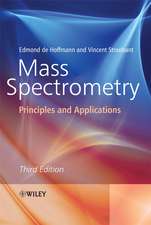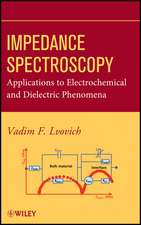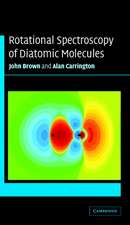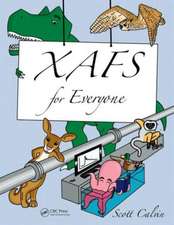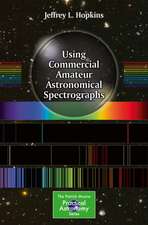Microscopic Methods in Metals: Topics in Current Physics, cartea 40
Editat de Ulrich Gonseren Limba Engleză Paperback – 25 feb 2012
Din seria Topics in Current Physics
-
 Preț: 393.13 lei
Preț: 393.13 lei -
 Preț: 401.61 lei
Preț: 401.61 lei - 15%
 Preț: 644.63 lei
Preț: 644.63 lei -
 Preț: 389.31 lei
Preț: 389.31 lei -
 Preț: 391.99 lei
Preț: 391.99 lei - 15%
 Preț: 642.18 lei
Preț: 642.18 lei -
 Preț: 388.90 lei
Preț: 388.90 lei -
 Preț: 382.95 lei
Preț: 382.95 lei -
 Preț: 398.53 lei
Preț: 398.53 lei -
 Preț: 402.98 lei
Preț: 402.98 lei -
 Preț: 387.96 lei
Preț: 387.96 lei -
 Preț: 388.72 lei
Preț: 388.72 lei -
 Preț: 393.13 lei
Preț: 393.13 lei -
 Preț: 397.38 lei
Preț: 397.38 lei - 15%
 Preț: 642.83 lei
Preț: 642.83 lei -
 Preț: 384.86 lei
Preț: 384.86 lei -
 Preț: 383.33 lei
Preț: 383.33 lei -
 Preț: 385.25 lei
Preț: 385.25 lei -
 Preț: 382.36 lei
Preț: 382.36 lei -
 Preț: 382.36 lei
Preț: 382.36 lei -
 Preț: 382.18 lei
Preț: 382.18 lei -
 Preț: 384.86 lei
Preț: 384.86 lei -
 Preț: 397.59 lei
Preț: 397.59 lei - 15%
 Preț: 639.08 lei
Preț: 639.08 lei -
 Preț: 396.62 lei
Preț: 396.62 lei -
 Preț: 391.40 lei
Preț: 391.40 lei -
 Preț: 382.75 lei
Preț: 382.75 lei -
 Preț: 392.75 lei
Preț: 392.75 lei -
 Preț: 392.60 lei
Preț: 392.60 lei - 15%
 Preț: 643.16 lei
Preț: 643.16 lei -
 Preț: 392.97 lei
Preț: 392.97 lei -
 Preț: 407.01 lei
Preț: 407.01 lei - 15%
 Preț: 638.43 lei
Preț: 638.43 lei -
 Preț: 394.87 lei
Preț: 394.87 lei -
 Preț: 395.09 lei
Preț: 395.09 lei - 15%
 Preț: 641.38 lei
Preț: 641.38 lei -
 Preț: 390.63 lei
Preț: 390.63 lei -
 Preț: 387.38 lei
Preț: 387.38 lei -
 Preț: 398.35 lei
Preț: 398.35 lei -
 Preț: 393.35 lei
Preț: 393.35 lei -
 Preț: 384.09 lei
Preț: 384.09 lei - 15%
 Preț: 641.03 lei
Preț: 641.03 lei -
 Preț: 397.01 lei
Preț: 397.01 lei -
 Preț: 395.47 lei
Preț: 395.47 lei - 15%
 Preț: 646.94 lei
Preț: 646.94 lei -
 Preț: 399.67 lei
Preț: 399.67 lei - 15%
 Preț: 642.83 lei
Preț: 642.83 lei - 15%
 Preț: 638.24 lei
Preț: 638.24 lei
Preț: 402.38 lei
Nou
Puncte Express: 604
Preț estimativ în valută:
77.01€ • 80.10$ • 63.57£
77.01€ • 80.10$ • 63.57£
Carte tipărită la comandă
Livrare economică 14-28 aprilie
Preluare comenzi: 021 569.72.76
Specificații
ISBN-13: 9783642465734
ISBN-10: 3642465730
Pagini: 476
Ilustrații: XVI, 457 p.
Dimensiuni: 170 x 244 x 25 mm
Greutate: 0.75 kg
Ediția:Softcover reprint of the original 1st ed. 1986
Editura: Springer Berlin, Heidelberg
Colecția Springer
Seria Topics in Current Physics
Locul publicării:Berlin, Heidelberg, Germany
ISBN-10: 3642465730
Pagini: 476
Ilustrații: XVI, 457 p.
Dimensiuni: 170 x 244 x 25 mm
Greutate: 0.75 kg
Ediția:Softcover reprint of the original 1st ed. 1986
Editura: Springer Berlin, Heidelberg
Colecția Springer
Seria Topics in Current Physics
Locul publicării:Berlin, Heidelberg, Germany
Public țintă
ResearchCuprins
1. Concerning Methods.- 1.1 Descriptive Methods.- 1.2 Abbreviated Methods.- 1.3 Name-Tag Methods.- 2. Scanning Acoustic Microscopy.- 2.1 Principle of Scanning Acoustic Microscopy (SAM).- 2.2 The Image Contrast of Solids in the Reflection Scanning Acoustic Microscope; V(z)-Curves.- 2.3 Examples of Practical Applications of Reflection Scanning Acoustic Microscopy.- 2.4 Outlook.- References27.- 3. High-Resolution Electron Microscopy.- 3.1 Background.- 3.2 Basic Principles of High-Resolution Electron Microscopy.- 3.3 Applications.- 3.4 Outlook.- References.- 4. Field Ion Microscopy.- 4.1 Principles and Techniques.- 4.2 Illustrative FIM Studies.- References.- 5. X-Ray and Neutron Diffraction.- 5.1 Diffraction of Neutrons and X-Rays by Poly- and Non-Crystalline Alloys.- 5.2 Experimental Techniques.- 5.3 Applications.- References.- 6. Extended X-Ray Absorption Fine Structure.- 6.1 Theory.- 6.2 Experimental Techniques.- 6.3 Analysis.- 6.4 Experimental Applications.- References.- 7. X-Ray Photoelectron Spectroscopy.- 7.1 Historical.- 7.2 Basic Principles.- 7.3 Related Methods.- 7.4 Applications.- 7.5 Recent Developments.- References.- 8. Auger Electron Spectroscopy.- 8.1 History.- 8.2 Principles.- 8.3 The Instrument.- 8.4 Related Methods.- 8.5 Applications.- 8.6 Future Developments.- References.- 9. Positron Annihilation.- 9.1 Background.- 9.2 Basic Principles.- 9.4 Applications.- 9.5 Conclusions and Outlook.- References.- 10. Muon Spectroscopy.- 10.1 Basic Principles of the Experimental Techniques.- 10.2 The Depolarization Functions.- 10.3 Diffusion Studies by ?+ SR.- 10.4 Magnetic Studies by ?+ SR.- 10.5 Conclusions.- References.- 11. Perturbed Angular Correlation.- 11.1 Background.- 11.2 Principles.- 11.3 Detection of Hyperfine Fields.- 11.4 Radioactive Probes, Preparationand Techniques.- 11.5 Applications.- 11.6 Future Developments and Conclusions.- References.- 12. Nuclear Magnetic Resonance.- 12.1 Introductory Comments.- 12.2 Physical Background of an NMR Experiment — Hyperfine Interactions.- 12.3 Basic NMR Experiment — Principles and Setup.- 12.4 NMR Outputs — Microscopic Origin.- 12.5 Applications — Structural Investigations.- 12.7 Conclusion and Outlook.- References.- 13. Mössbauer Spectroscopy.- 13.1 History.- 13.2 Principles.- 13.3 Mössbauer Isotopes.- 13.4 Methodology.- 13.5 Hyperfine Interactions.- 13.5.1 Isomer Shift.- 13.6 Relativistic Effects.- 13.7 Time-Dependent Effects.- 13.8 Applications.- 13.9 Outlook.- References.- Additional References with Titles.
